Try my easy homemade recipe for Yuzu Cha (Citron Tea) with fresh yuzu fruit and rock sugar. Stir a spoonful of this sweet, tart, and fragrant preserved citrus syrup into hot water for an invigorating and immune-boosting beverage on cold days.
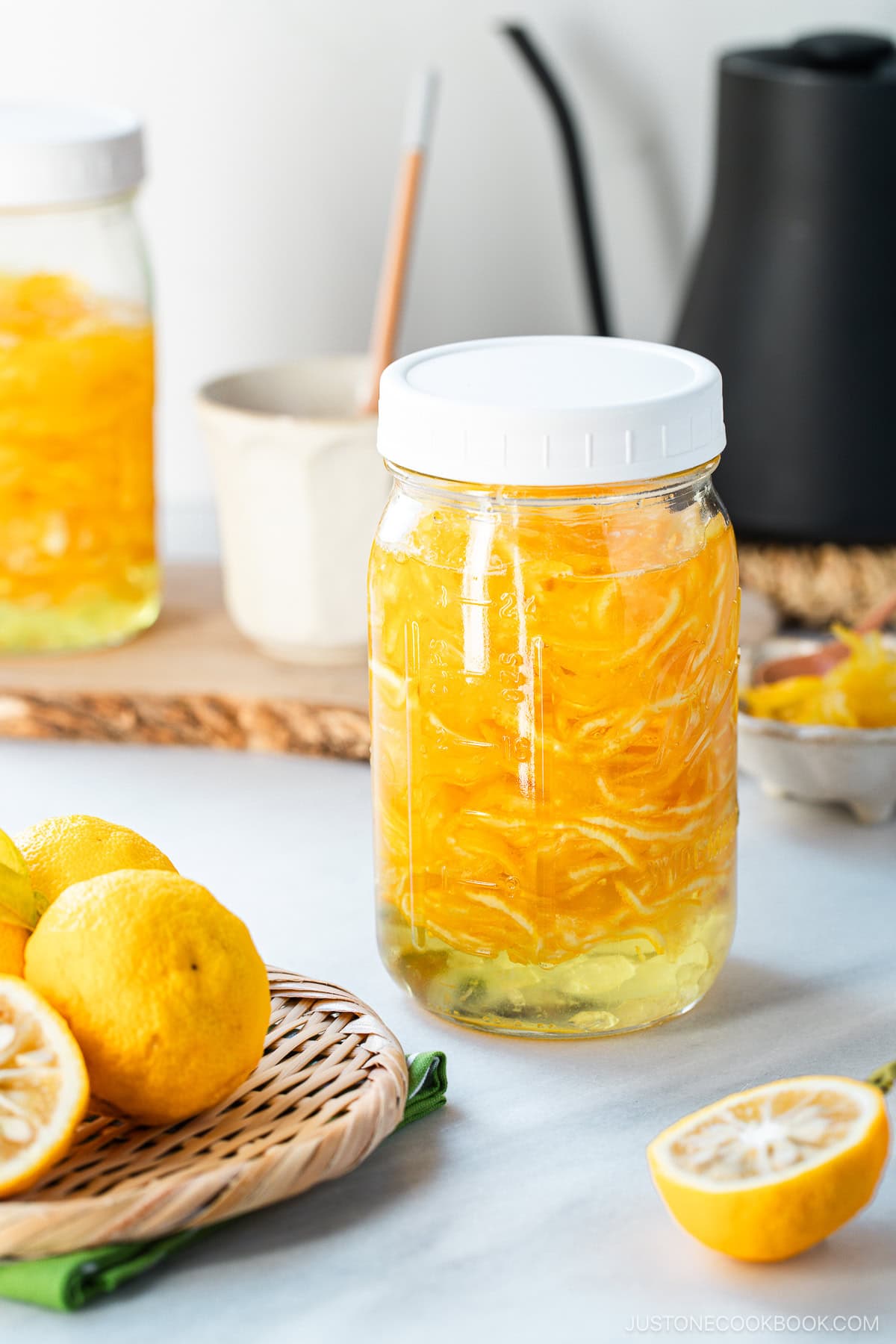
I’m completely obsessed with yuzu, a small Japanese citrus fruit with a distinct floral fragrance and a bright, fruity, and citrusy flavor. It’s hard to find in the US, so I planted my own small tree in my yard! I love to use this fresh yellow fruit to make homemade Yuzu Cha (Citron Tea), the recipe that I’m sharing today. This preserved yuzu syrup is so easy to make! I can’t wait for you to try it in a delicious restorative hot drink on cold winter days.
If you love the taste of yuzu fruit, try my Yuzu Ponzu, Yuzu Sorbet, and Yuzu Marmalade next!
What is Yuzu Cha?
Yuzu cha (ゆず茶, yuzu “tea,” citron tea) originated in Korea, where it’s called yuja-cheong and yuja cha referring to yuja fruit, the Korean name for yuzu. It is a preserved yuzu syrup made from sugar and raw yuzu rind, flesh, pulp, and juice. It’s also what we call the fruit tea made with a spoonful of yuzu syrup stirred into hot water. This “tea” contains neither tea leaves nor caffeine, so people of any age can enjoy it any time of day.
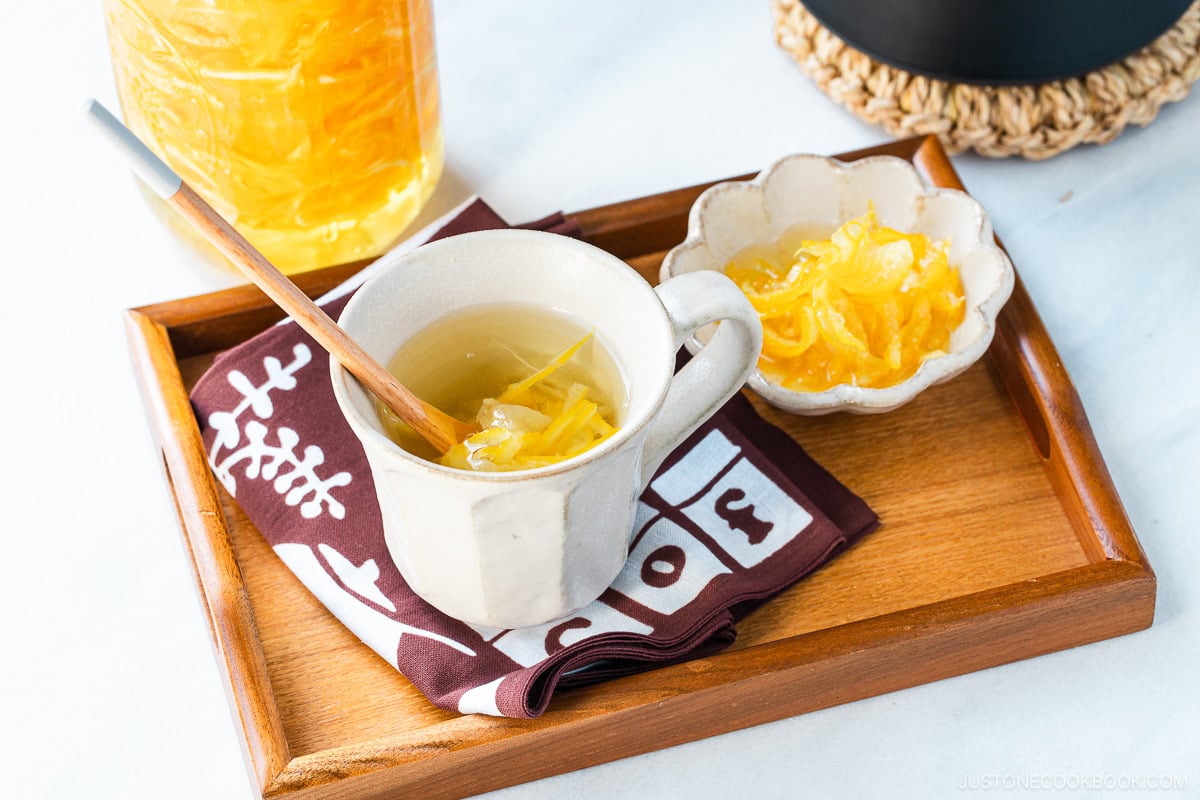
Why I Love This Recipe
- No cooking necessary! – Simply clean and prepare the yuzu, then layer it in jars with rock sugar, and rest it for 7 days. That’s it! I love how easy it is to make this syrup compared to other preservation methods that call for boiling the fruit and sugar.
- A simple method to preserve fresh yuzu – My recipe is a great way to use this rare and precious fruit when it’s in season and enjoy it for a long time! It keeps for 1–2 months in the fridge.
- No additives – Many yuzu cha products like jam, powder, and tea bags sold in stores contain additives. I really like that this recipe uses only two ingredients—fresh yuzu and rock sugar—so I know exactly what I’m feeding to my family.
- Yuzu restores energy and fights colds – I feel refreshed and invigorated after drinking a hot cup of yuzu tea. The tart and sour citrus fruit has citric acid and malic acid that help your body recover from fatigue. It’s also rich in Vitamin C to help your body fight colds and boost its immune system.
- A delicious way to enjoy yuzu’s health benefits – Yuzu is rich in flavonoids, a polyphenol with high antioxidant properties that can help prevent certain diseases. It’s also abundant in pectin, a type of dietary fiber that supports good bacteria for improved gut health. I stir a spoonful into hot water and enjoy it as a healthy tonic.
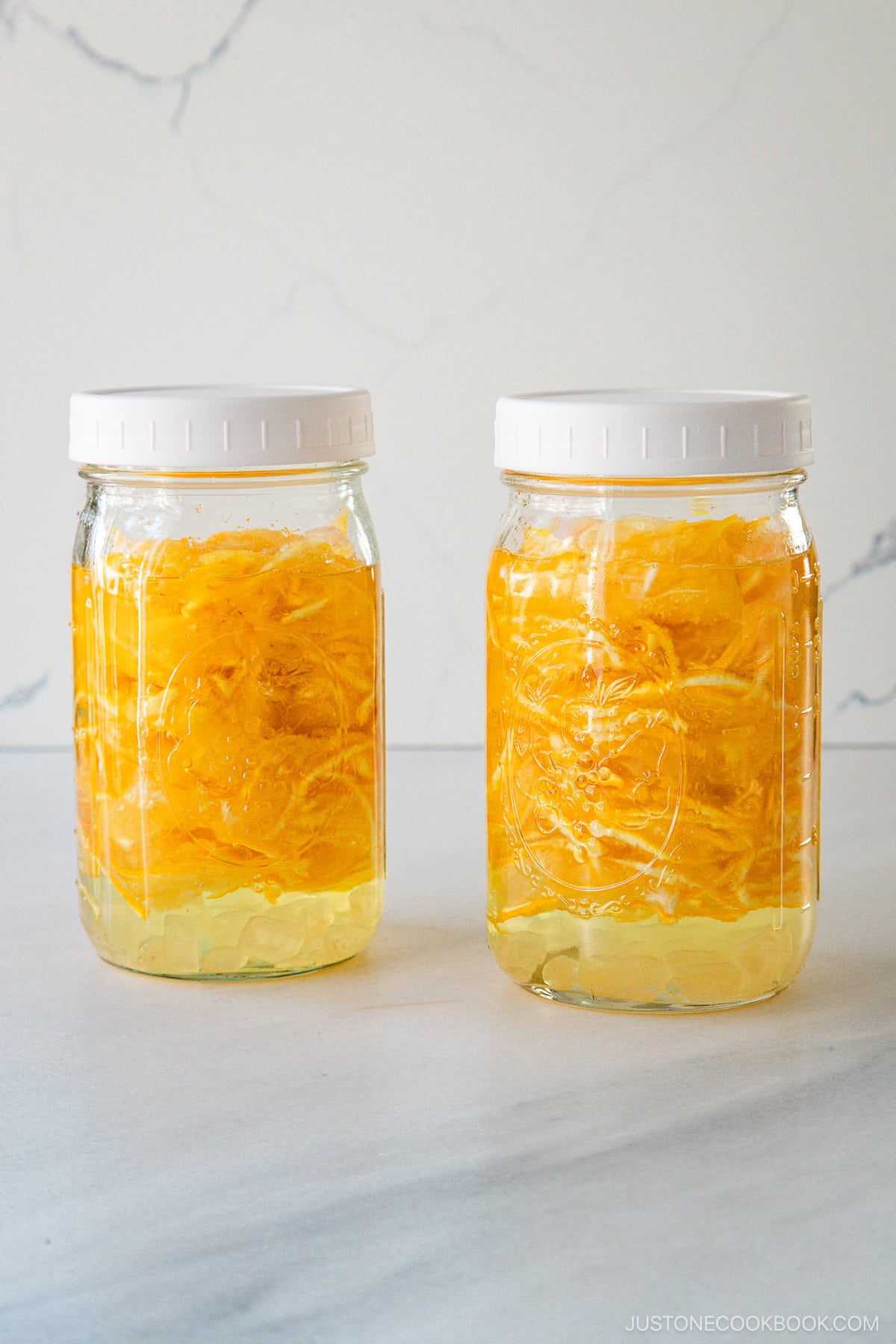
Ingredients for Yuzu Cha
- Fresh yuzu fruit
- White rock sugar
Find the printable recipe with measurements below.
Substitutions
- Rock sugar: Most Korean yuja tea recipes use granulated sugar. If you substitute white sugar, be sure to refrigerate the yuzu cha as soon as the sugar dissolves. Some Japanese recipes also use honey instead of rock sugar; if you substitute it, be aware that the yuzu cha will not keep as long if you use honey instead of sugar.
Key Kitchen Equipment
- Digital kitchen scale – to weigh your ingredients
- Mason jars with lids – I use 16-oz. size (two jars per batch)
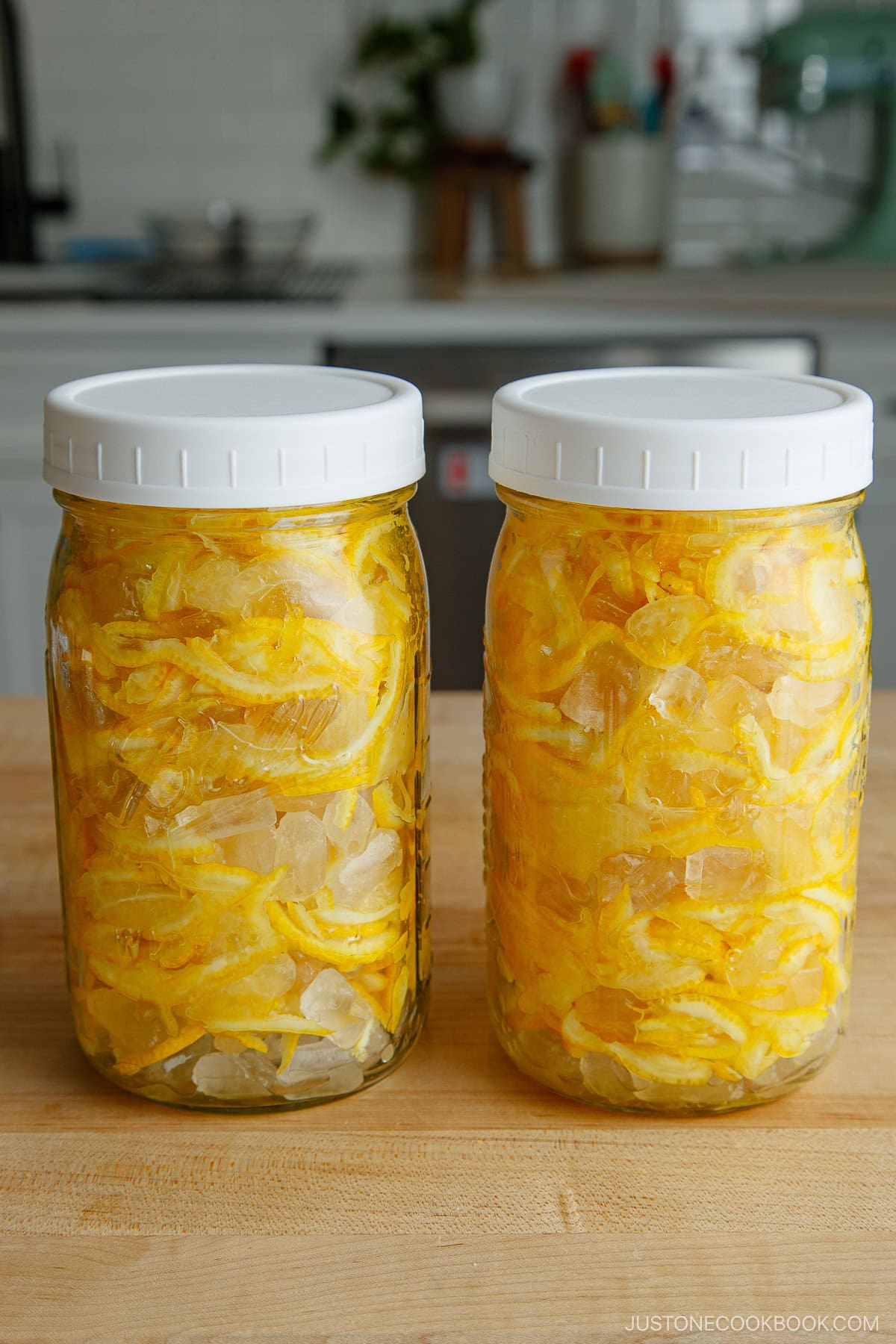
How to Make Yuzu Cha
Preparation
Step 1 – Peel and clean the yuzu. Rinse and dry the yuzu, then score the rind on the bottom with an X. Peel off the rinds and set them aside. Separate the fruit segments and remove any stringy white membrane. Place the fruit in a large tray or bowl.
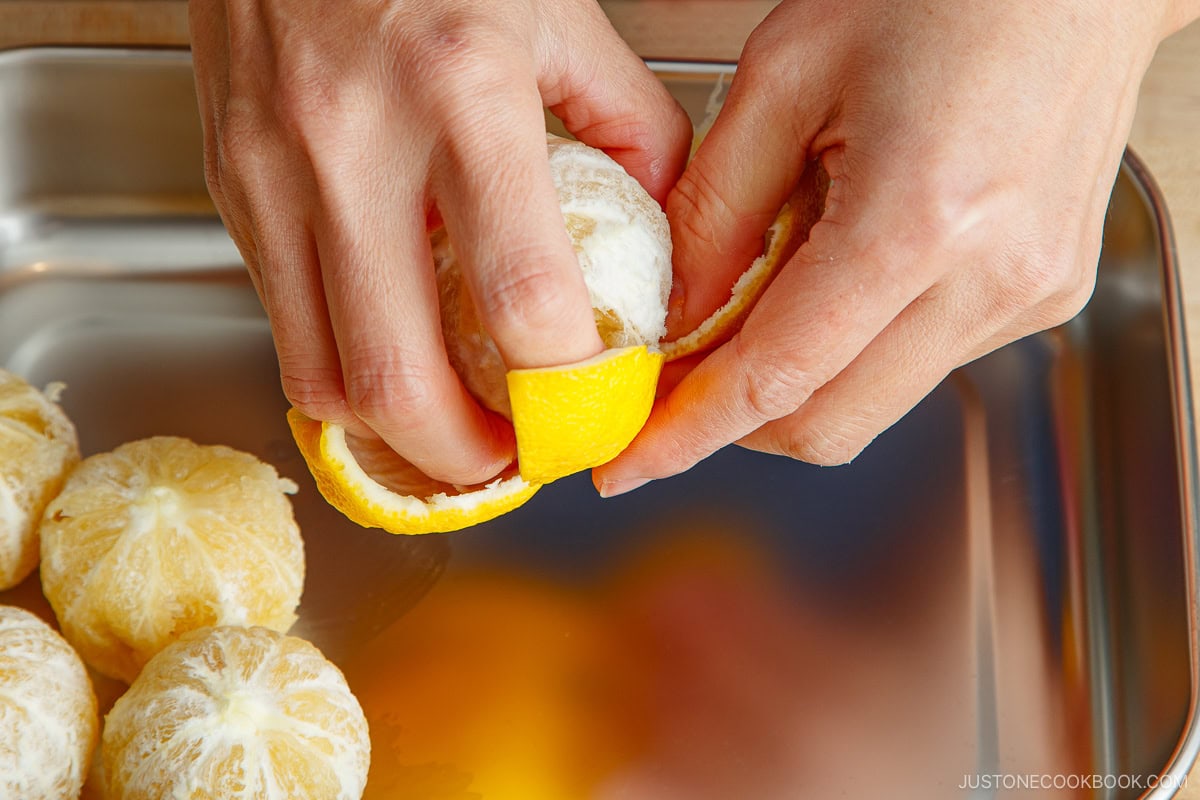
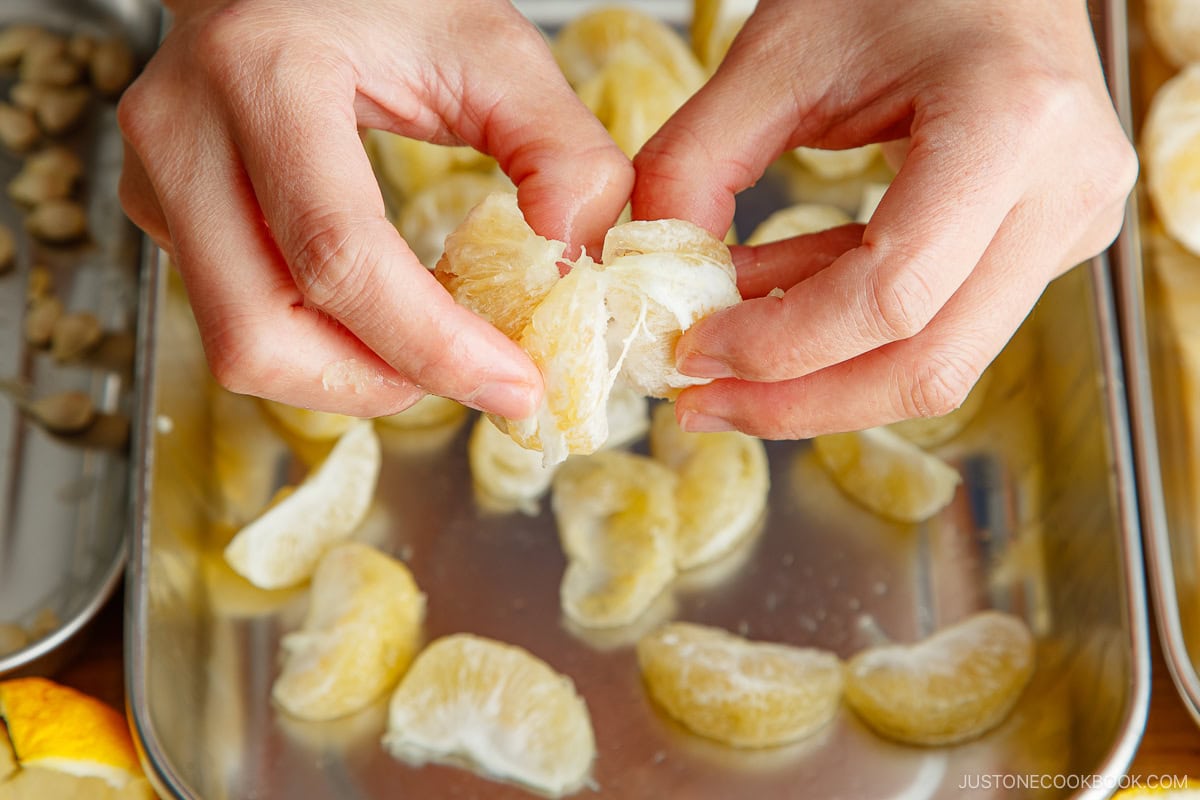
Step 2 – Remove the seeds and slice the rinds. Cut each segment in half crosswise and remove the seeds. Remove the stem or “button” from the rinds and thinly julienne them lengthwise.
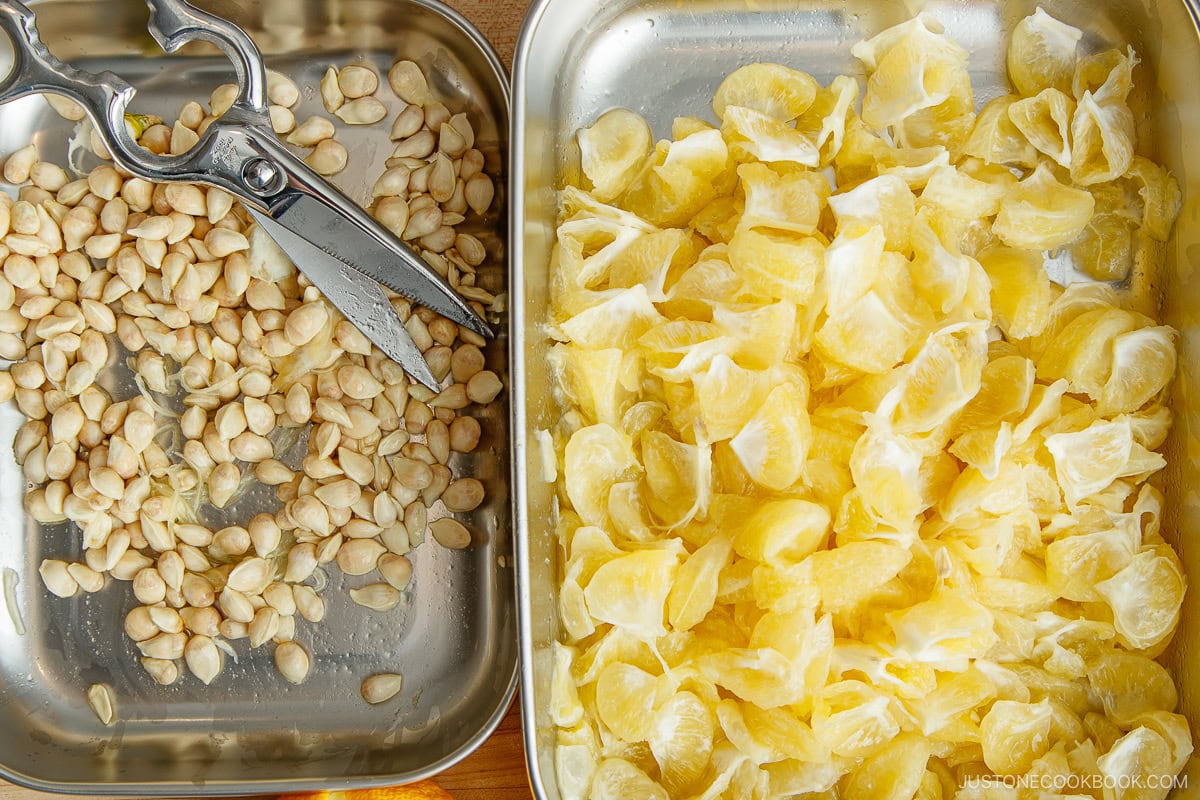
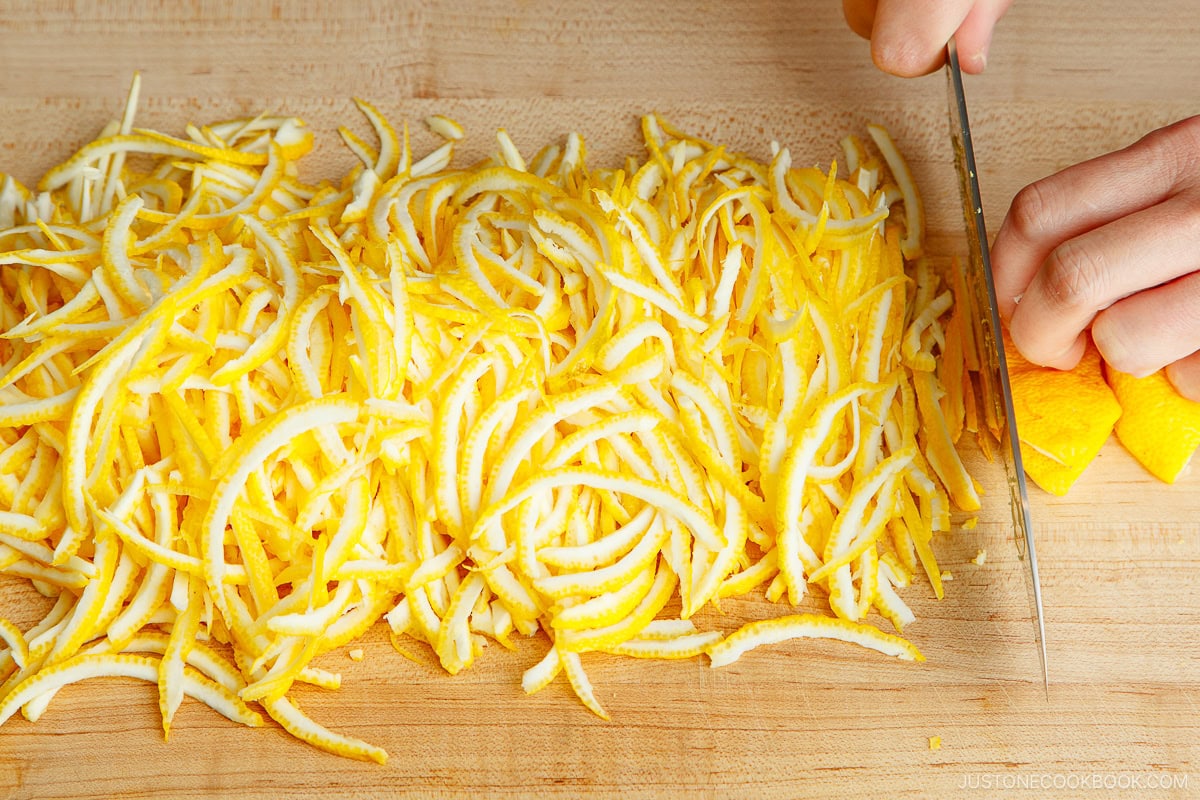
Assemble
Step 3 – Rub the rinds and fruit together, then layer with rock sugar into jars. Massage the rinds with the fruit to soften. Layer the yuzu mixture with rock sugar into sterilized glass jars, pressing the layers as you go to remove any air gaps.
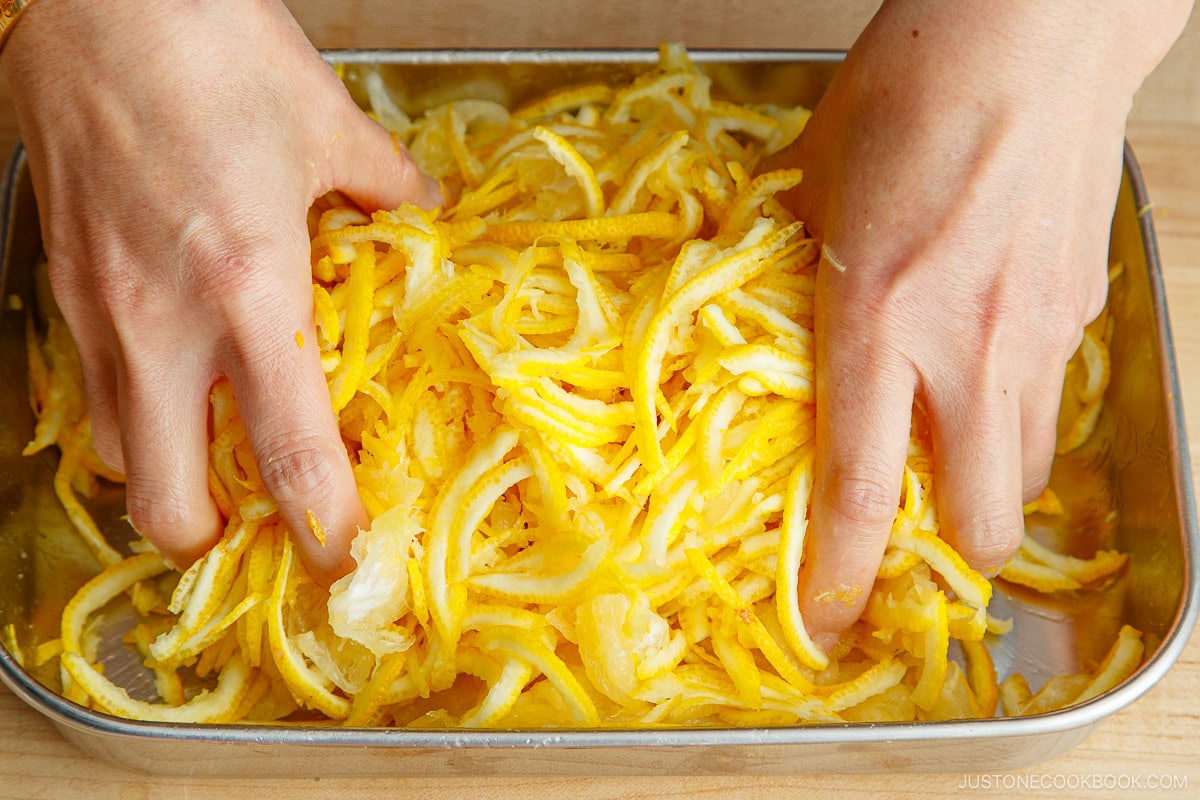
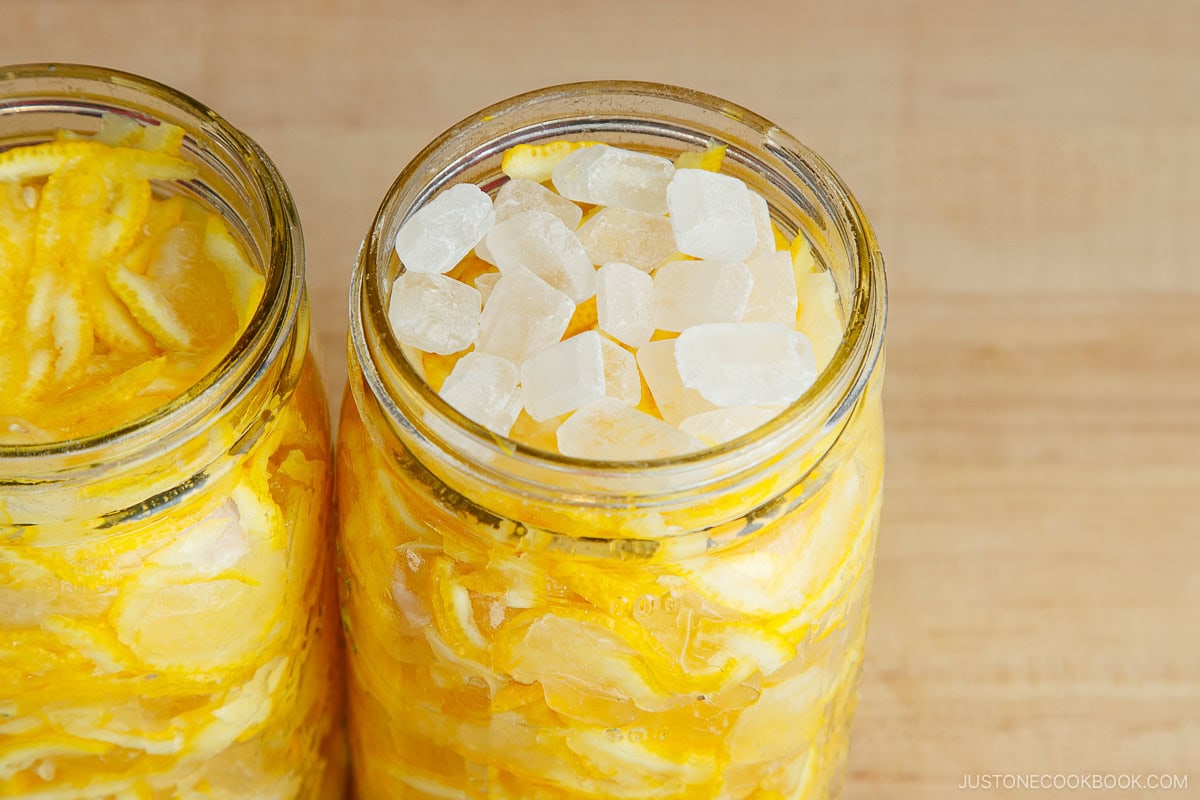
Step 4 – Rest and preserve the yuzu cha for one week. Close the lids and keep the jars in a cool place for 7 days. Gently shake and tilt the jars at least once a day to make sure the yuzu is coated with syrup. When it’s done, move the jars to the fridge to store.
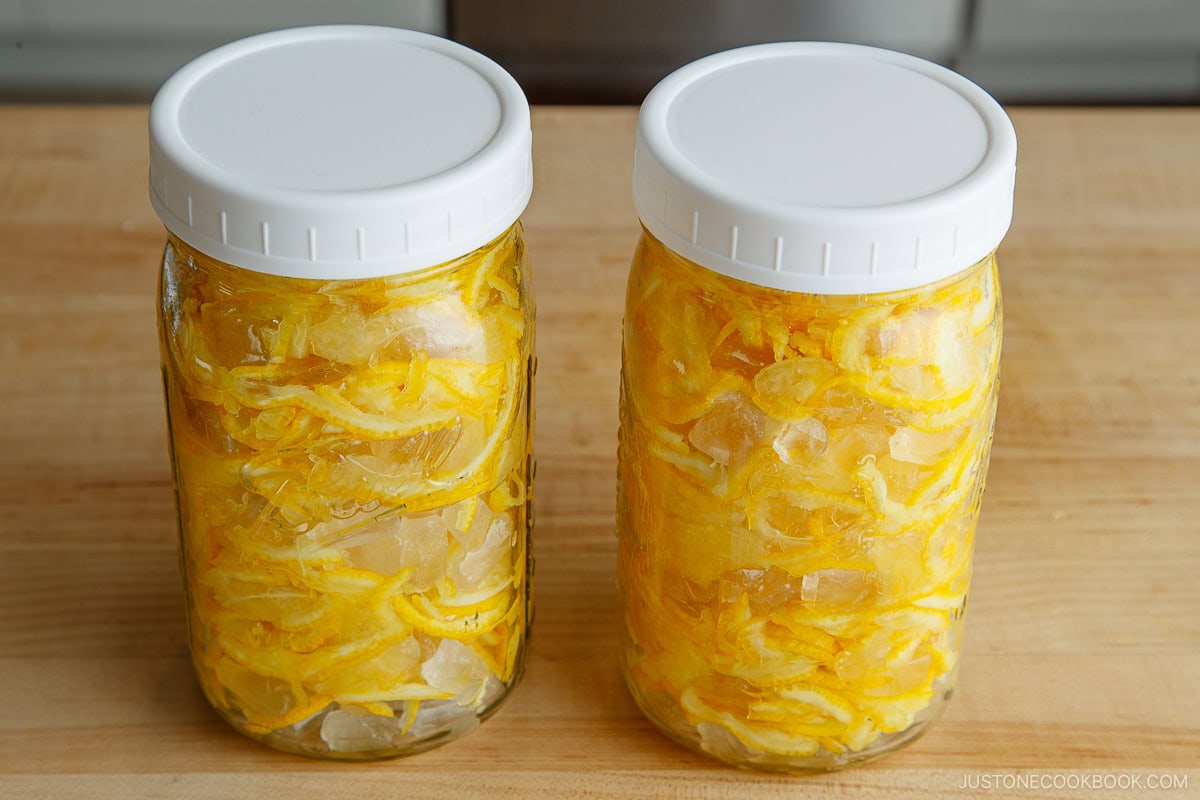
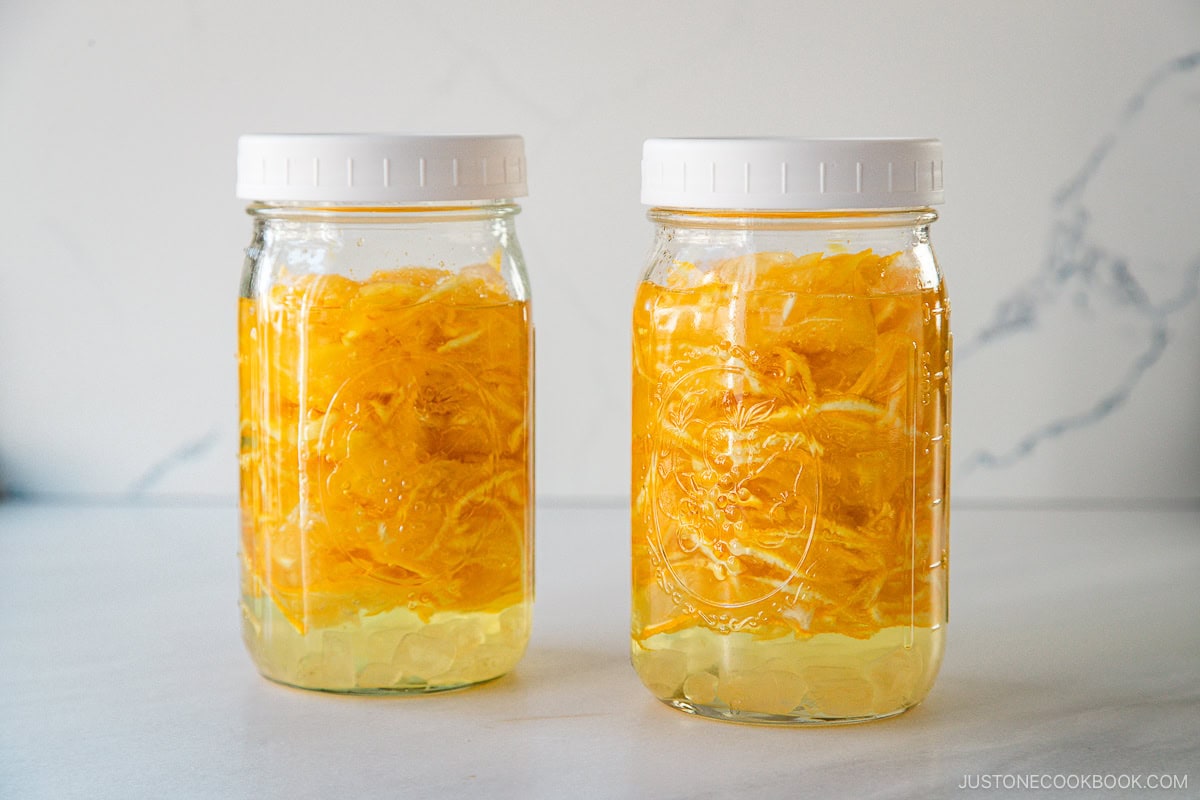
Nami’s Recipe Tips
- Completely dry your yuzu fruit after rinsing them. Any excess water can encourage mold growth.
- Use the same amount of yuzu and sugar by weight – Please use a 1-to-1 ratio of yuzu to rock sugar to properly preserve the fruit. You can always add more sugar if you prefer it sweeter, but please do not reduce the amount. I recommend weighing all your ingredients with a digital kitchen scale.
- Make sure your mason jars and lids are completely dry. Any drops of water in your mason jar can cause mold to form.
- Sterilize your jars with shochu – It’s important to sterilize your clean mason jars with shochu, vodka, or any alcohol higher than 35% ABV.
- Completely cover the top layer of yuzu with rock sugar – This helps prevent mold from forming.
- Tilt the jar daily to coat the yuzu with syrup – While the yuzu is resting in the jars, be sure to gently shake the jar to keep the yuzu covered with syrup. This helps inhibit mold growth.
- Refrigerate once the sugar dissolves – The rock sugar takes about 7 days to dissolve, at which point you can move it to the fridge where it will keep for 1–2 months.
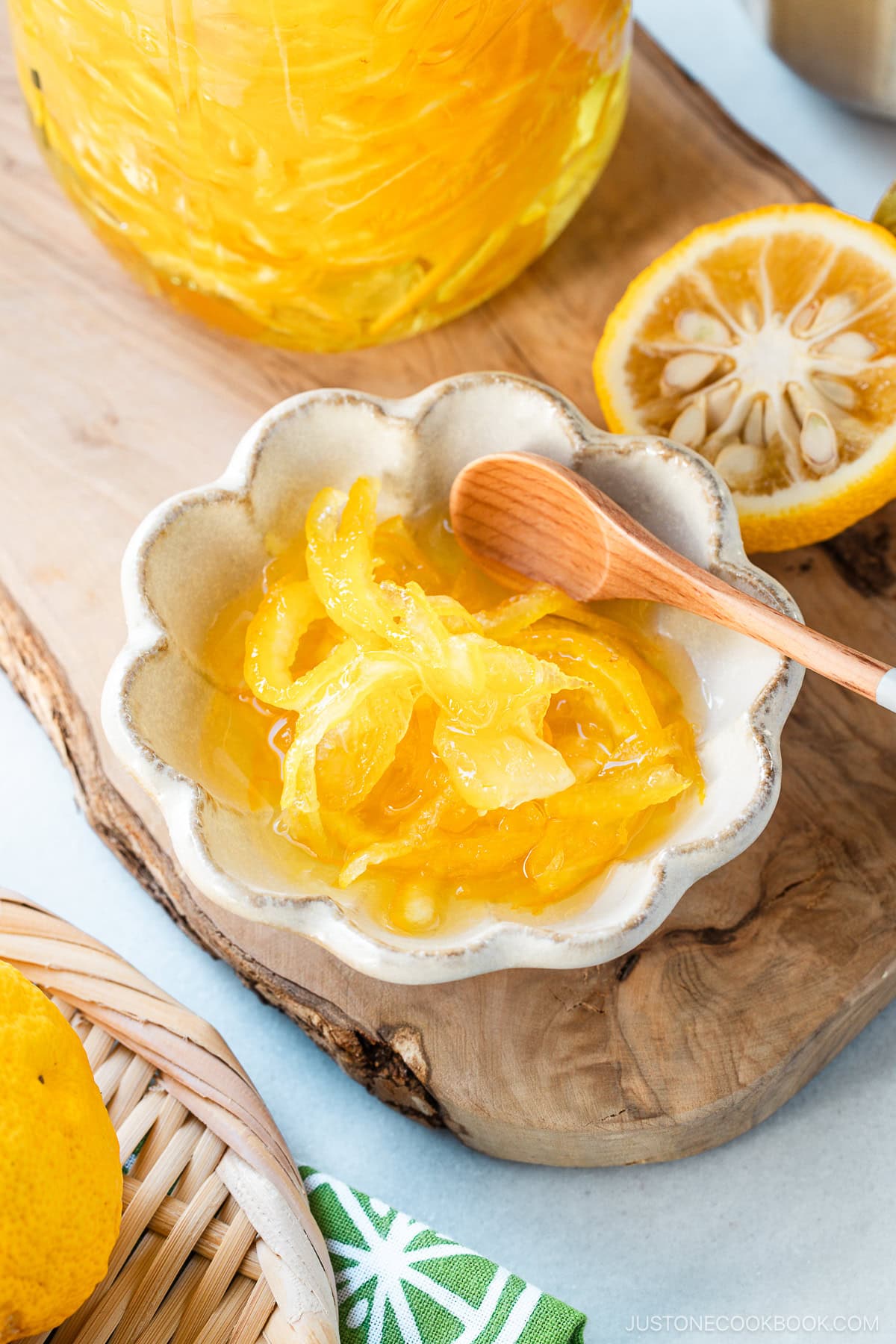
Variations and Customizations
While this recipe calls for only two ingredients, there are several ways to customize your yuzu cha to change up the flavors. Here are some of my suggestions.
- Add honey. For a unique depth of flavor, add some honey to the rock sugar. Just make sure to keep the total weight of the sugars (rock sugar + honey) and the yuzu at the same 1-to-1 ratio called for in my recipe.
- Mix in ginger slices. Fresh ginger adds a warm, spicy taste to this syrup and boosts the health benefits of your yuzu cha. In Japan, we even make a similar hot tea with ginger and honey as a potent cold and flu remedy. Peel and cut fresh ginger into thin slices or sticks and mix into the yuzu fruit and rinds before layering with the rock sugar.
- Use Meyer lemons. You can make a similar preserved citrus syrup using Meyer lemons instead of yuzu!
- Add your favorite spices. Experiment with your favorite flavors to add a unique twist to your yuzu cha. Cinnamon, cardamom, cloves, star anise, and vanilla pods are popular spices in Western cuisine that pair well with citrus.
How to Serve Yuzu Cha
Here, I recommend some other delicious ways to enjoy this yuzu syrup and preserved peel.
- In hot citron tea – The most common way to enjoy yuzu cha is mixed into a cup of hot water for a restorative beverage that’s similar to lemon tea. This is very similar to Korean citron tea or Korean honey citron tea.
- In an iced drink – You can add yuzu cha to plain water over ice cubes for a refreshing summertime drink. You can also mix it into a Japanese Yuzu Cocktail (Chuhai) or non-alcohol yuzu spritz.
- In hot black tea – Mix a heaping spoonful into freshly brewed black tea.
- On toast – Use it just like jam on toasted Japanese Milk Bread (Shokupan)
- In ice cream – Use a few tablespoons in a refreshing Yuzu Ice Cream or add a dollop on top of a vanilla ice cream scoop.
- In agar jelly – Stir yuzu cha into Kanten Jelly for a refreshing summertime dessert!
- In yogurt or chopped fruit – Yuzu cha is delicious when mixed into plain or vanilla yogurt, or when added to chopped apples.
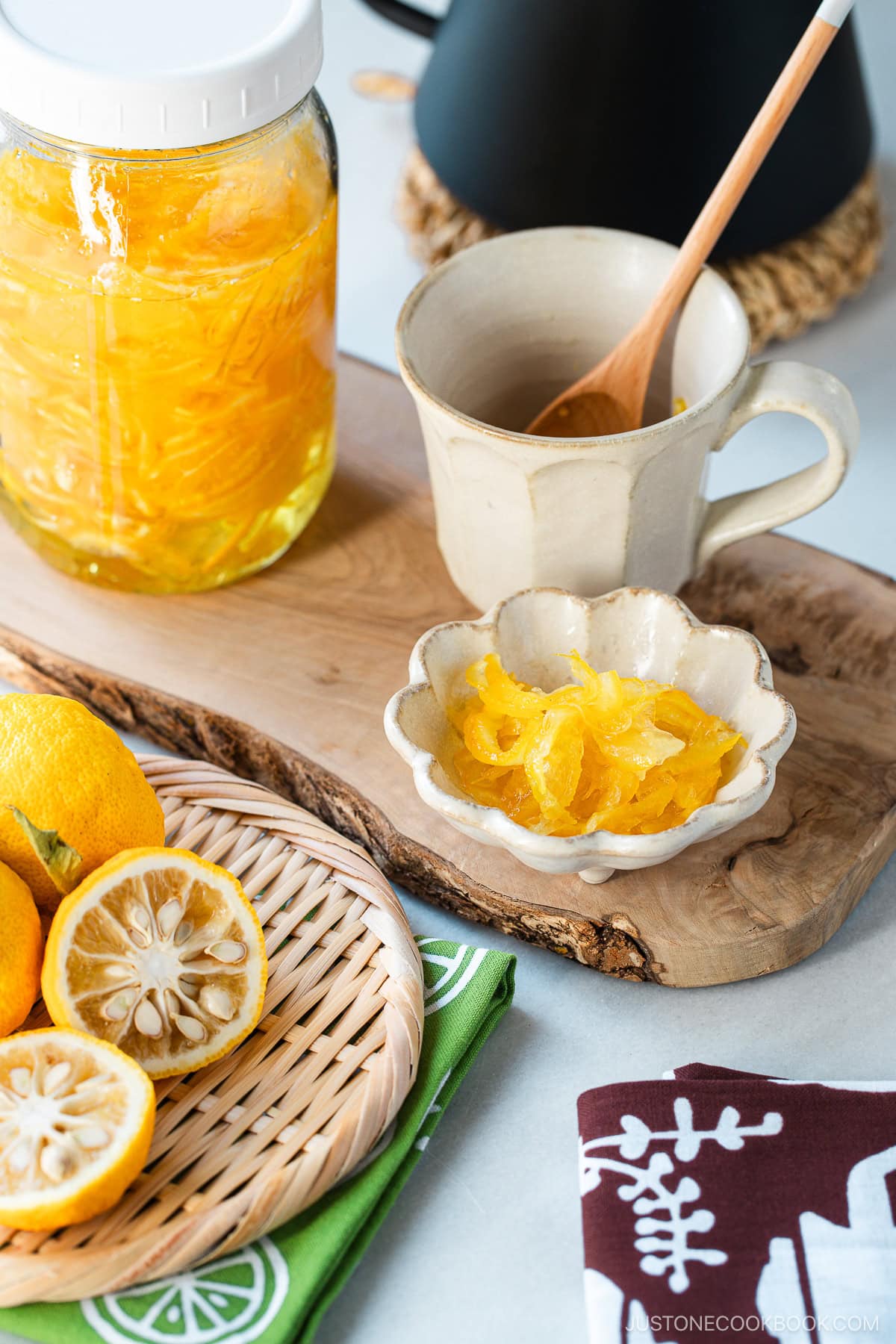
Storage Tips
To store: Once your yuzu cha is done resting for 7 days, you can store it in the refrigerator for up to 1–2 months.
Frequently Asked Questions
About Yuzu Cha
Can I reduce the amount of sugar used?
I don’t recommend it. Sugar helps to preserve the yuzu and extend the shelf life of the yuzu cha. Please use an equal amount (by weight) of sugar to yuzu fruit.
What can I use instead of rock sugar?
You can substitute an equal amount of granulated sugar or honey.
My yuzu cha developed a spot of mold on top. Can I still use it?
If you see a bit of mold on top of your yuzu cha, you must assume that there are mold spores inside the syrup. Therefore, please throw away the entire jar of yuzu cha if it starts growing mold.
About Yuzu Fruit
What exactly is yuzu?
Yuzu is a small yellow or green citrus fruit that’s been used for centuries in Japanese and Korean cooking. In Korea, it’s called yuja. It’s highly prized in Japanese cuisine for its intense fragrance and flavor. It has an aromatic zest and a floral, tart-sweet juice. Japanese cuisine places great emphasis on color and aroma, and yuzu is often the magical ingredient that elevates many dishes.
Yuzu has a thick pith and thick skin that’s bumpy and often scarred from the sharp thorns of the yuzu tree. What’s more, yuzu has lots of seeds—a lot more than the typical citrus fruit. It feels squishy and airy from the outside; it’s not hard and plump like a lime or lemon.
Yuzu is a very precious and expensive fruit outside of Japan, and it’s not easy to find it fresh in the US. You might find it in the wintertime at Japanese grocery stores and local farmer’s markets.
What does yuzu taste like?
Fresh yuzu juice tastes like a complex blend of sour, sweet, and floral flavors. I’d describe it as a good combination of tart lemon, bitter grapefruit, sweet orange, and fragrant pomelo. It has a highly fragrant and aromatic zest and a bitter and spongy pith.
How can I use yuzu in Japanese cooking?
In Japan, we use yuzu in both sweet and savory Japanese dishes, just as you would use lemon in cooking and baking. Yuzu zest is a lovely garnish for soups, chawanmushi (steamed savory custard), and Japanese pickles (tsukemono). We add the juice to hot pots, dipping sauce, and grilled fish and meat. We use the zest and juice to flavor baked goods like pound cakes and chiffon cakes. Finally, you can make yuzu marmalade, yuzu ice cream, yuzu sorbet, and the popular fermented citrus chili paste called yuzu kosho.
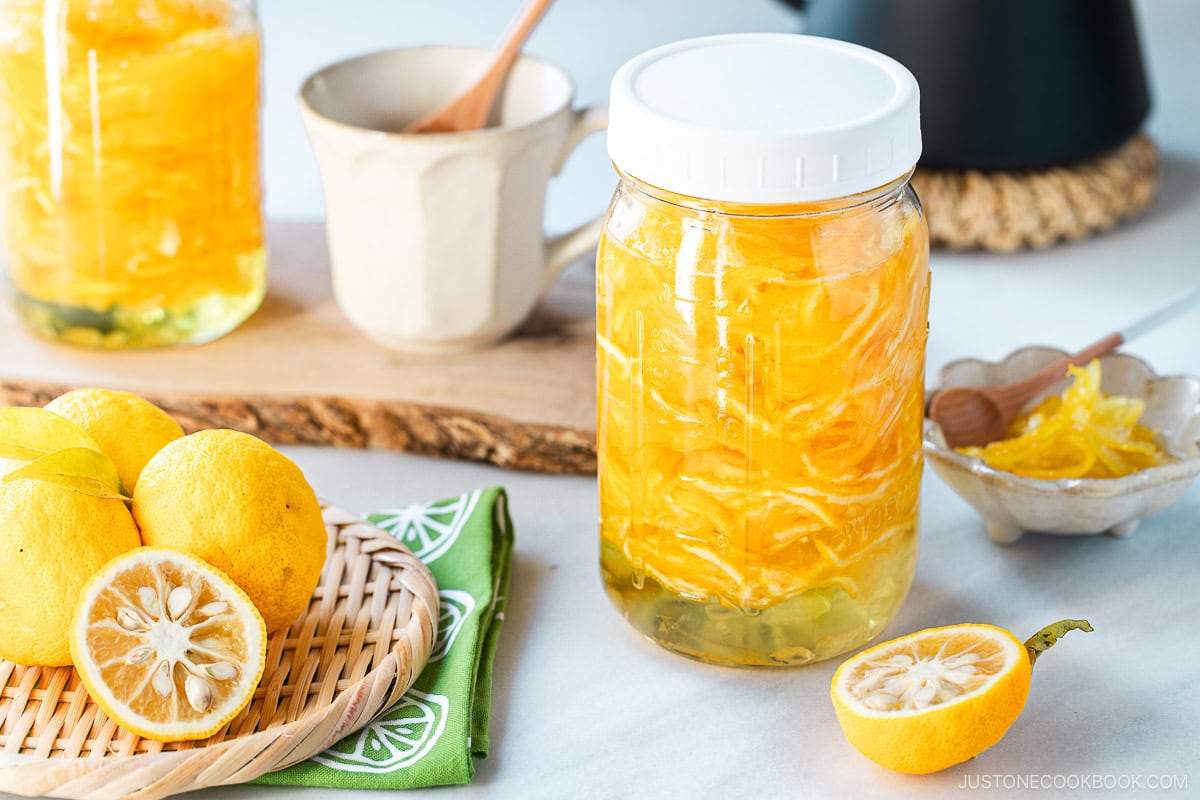
More Healthy Beverage Recipes
If you love this Yuzu Cha, you’re in for a treat with these other irresistible recipes for healthy drinks.
- Honey Ginger Tea (Shogayu)
- Kinako Milk
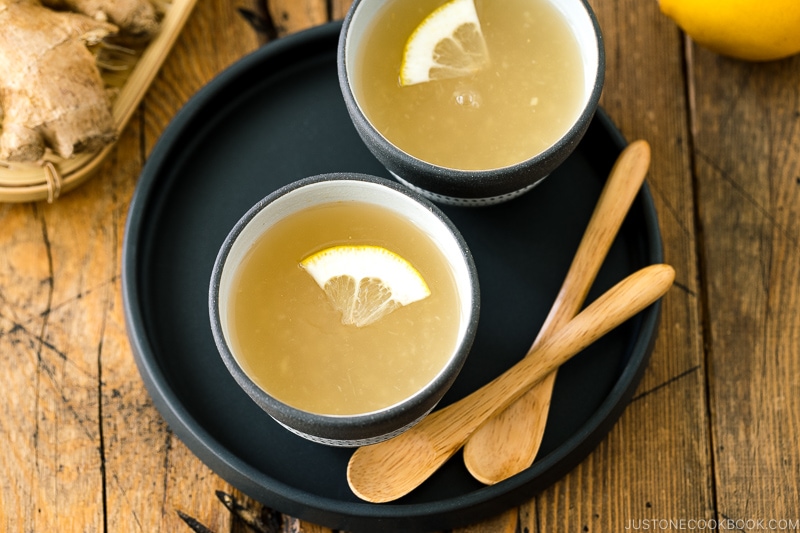

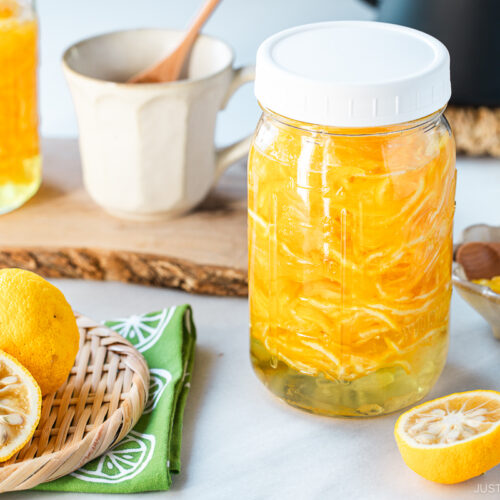
Prep Time: 1 hour
Resting Time: 7 days
Total Time: 1 hour
For Cleaning the Jars
- ▢ ½ cup shochu (for sterilizing; or use vodka or any alcohol higher than 35% ABV)
Japanese Ingredient Substitution: If you want substitutes for Japanese condiments and ingredients, click here.
To Peel and Clean the Yuzu
Rinse 2.2 lbs yuzu and dry well with a kitchen towel. Score the rind on the bottom with an X using a sharp knife. This makes peeling easier.
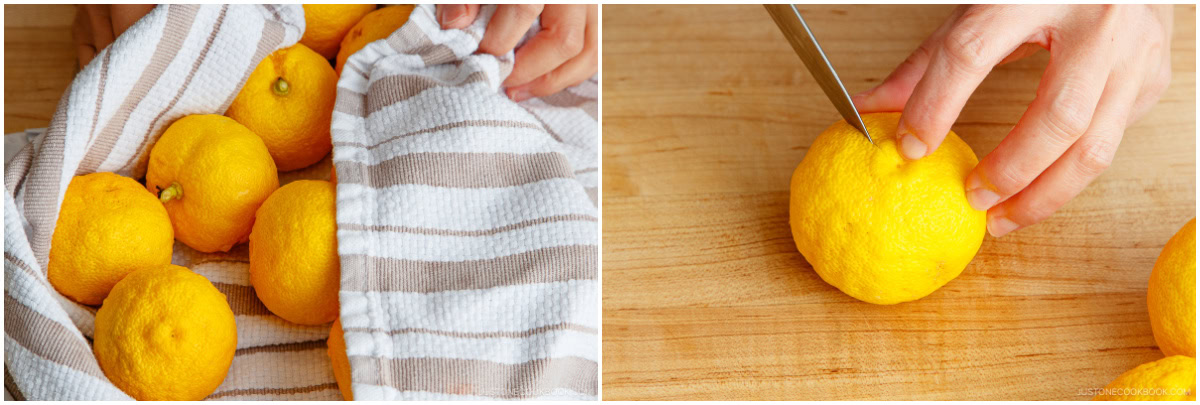
Peel off the rinds with your fingers. The bumpy and loose skin should come off in one piece. Set the rinds aside for now. Then, separate each fruit segment and place them in a large tray. Tip: Work over the tray while you handle the fruit to collect any juice, which you will use later.
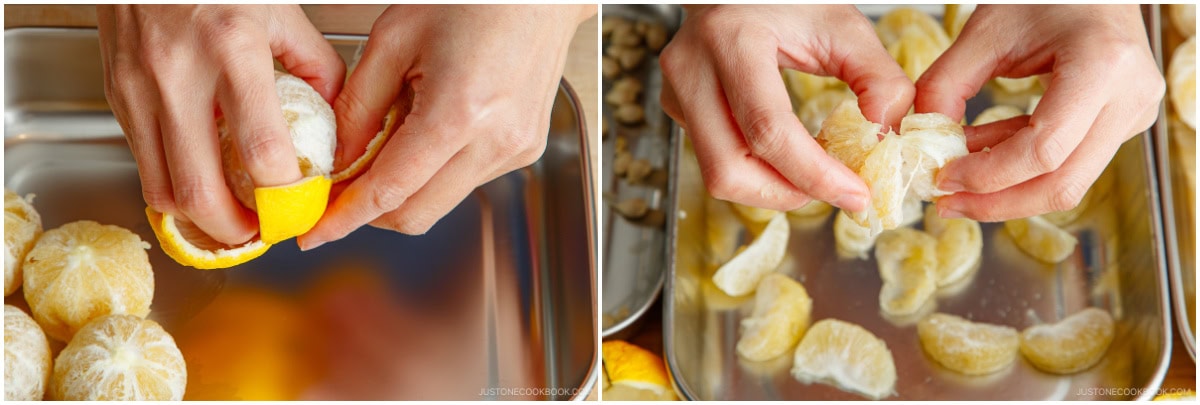
Remove any stringy white membrane from the fruit (but leave the membrane wall intact). I collect the stringy membrane and any seeds that fall out in a separate small tray to discard after the next step.
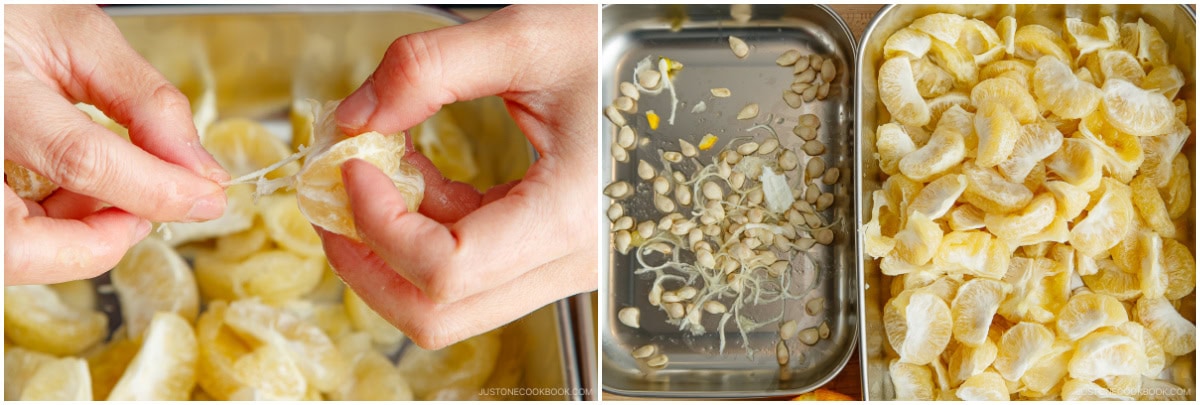
To Remove the Seeds
Cut each segment in half crosswise with kitchen scissors, working over the tray to any collect the juice. Remove the seeds. Place the seeded halves in another large tray.
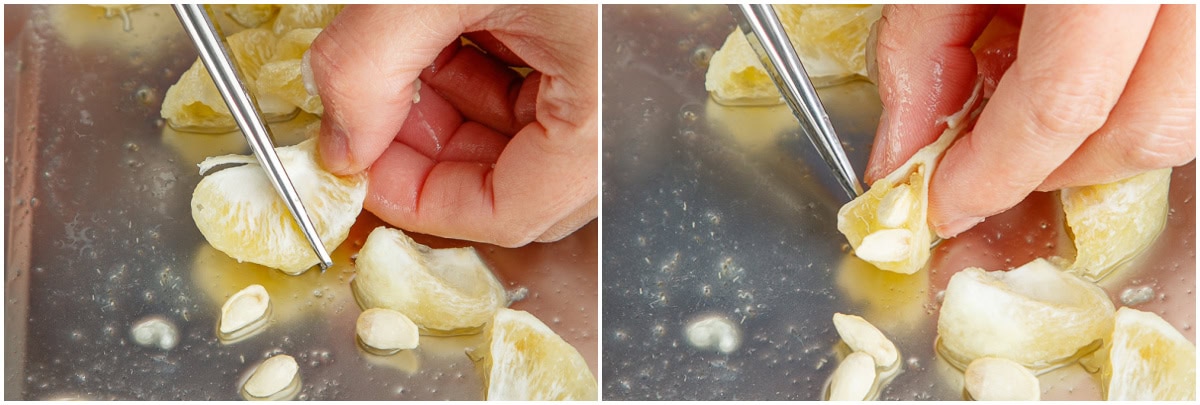
When you are done, discard the seeds and stringy membrane.
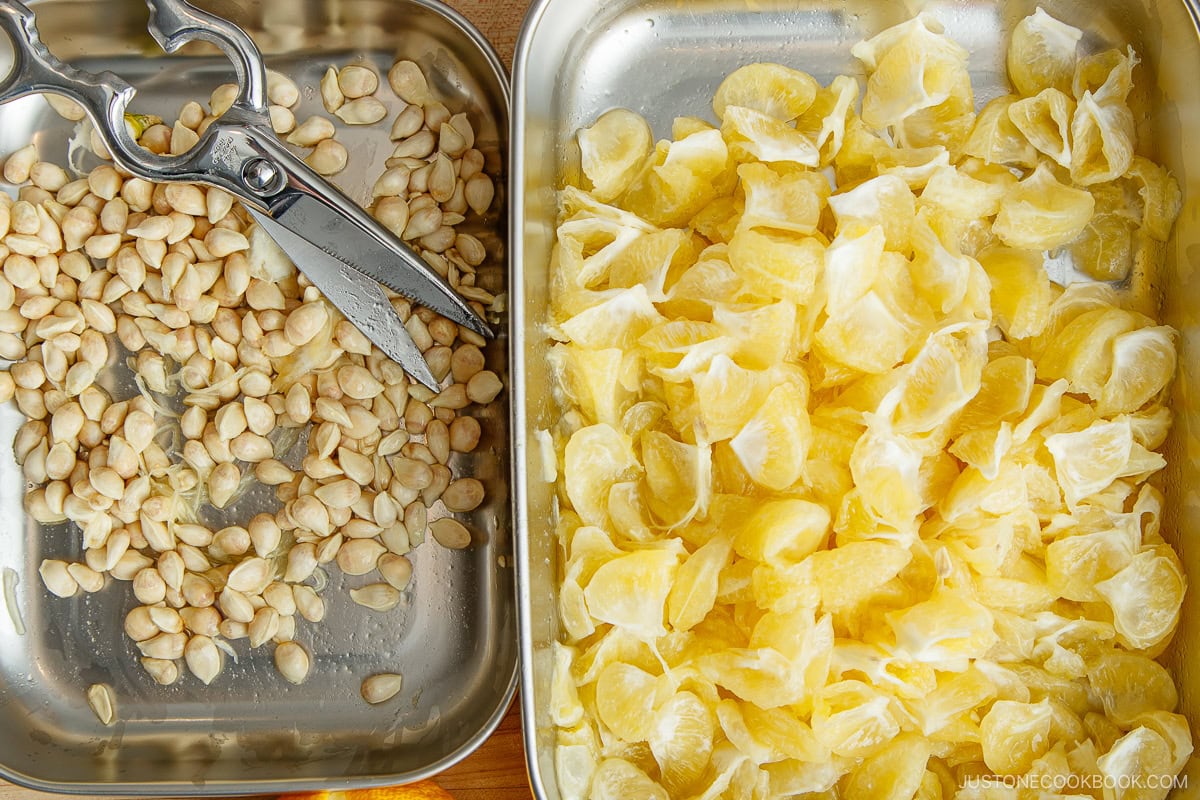
To Slice the Rinds
Remove the stem or "button" attached to the rinds. Then, thinly julienne the rinds lengthwise.
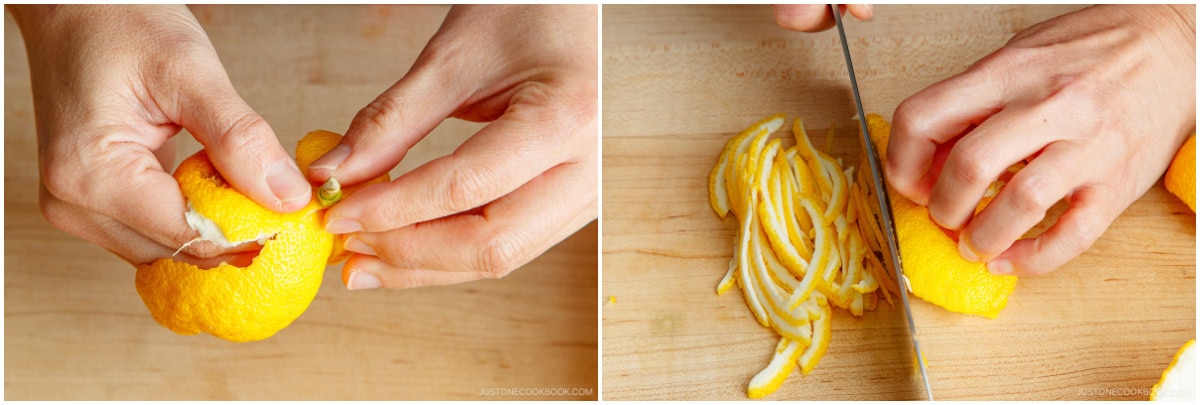
Once you finish slicing, add the rinds to the large tray with the seeded fruit. Add any of the collected juice from the other trays.
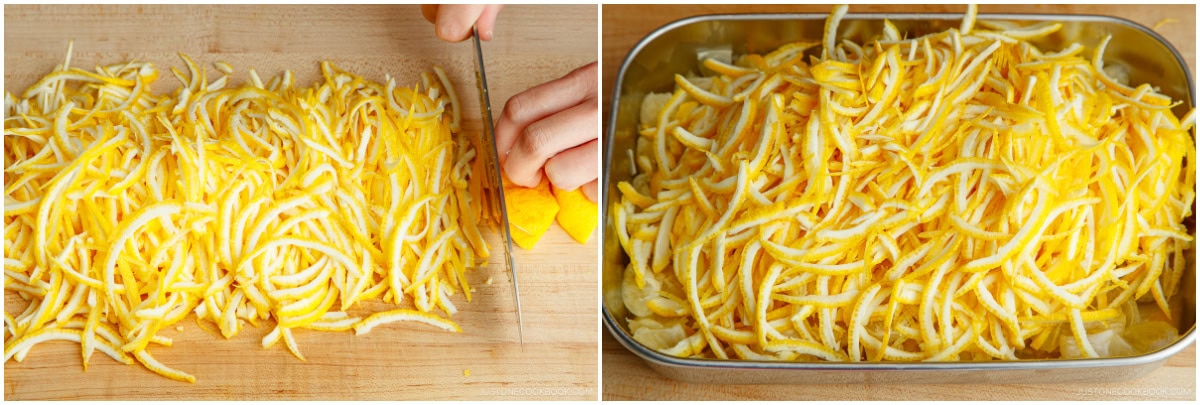
Then, squeeze and rub everything together until the rinds start to soften.
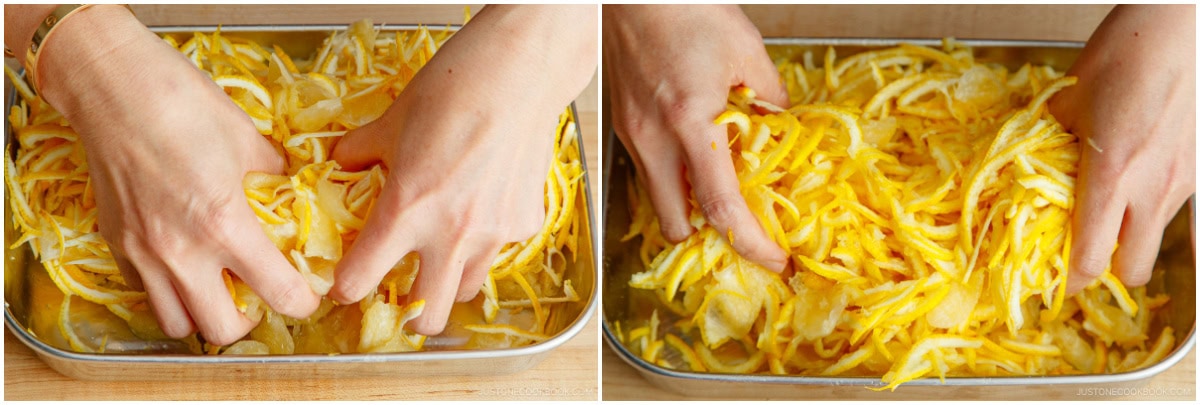
To Clean the Jars
Divide ½ cup shochu into 2 clean and dry mason jars (16 oz each). Close the lids and shake the alcohol around the inside surfaces of the jar and lid. Then, pour it out and let air dry.
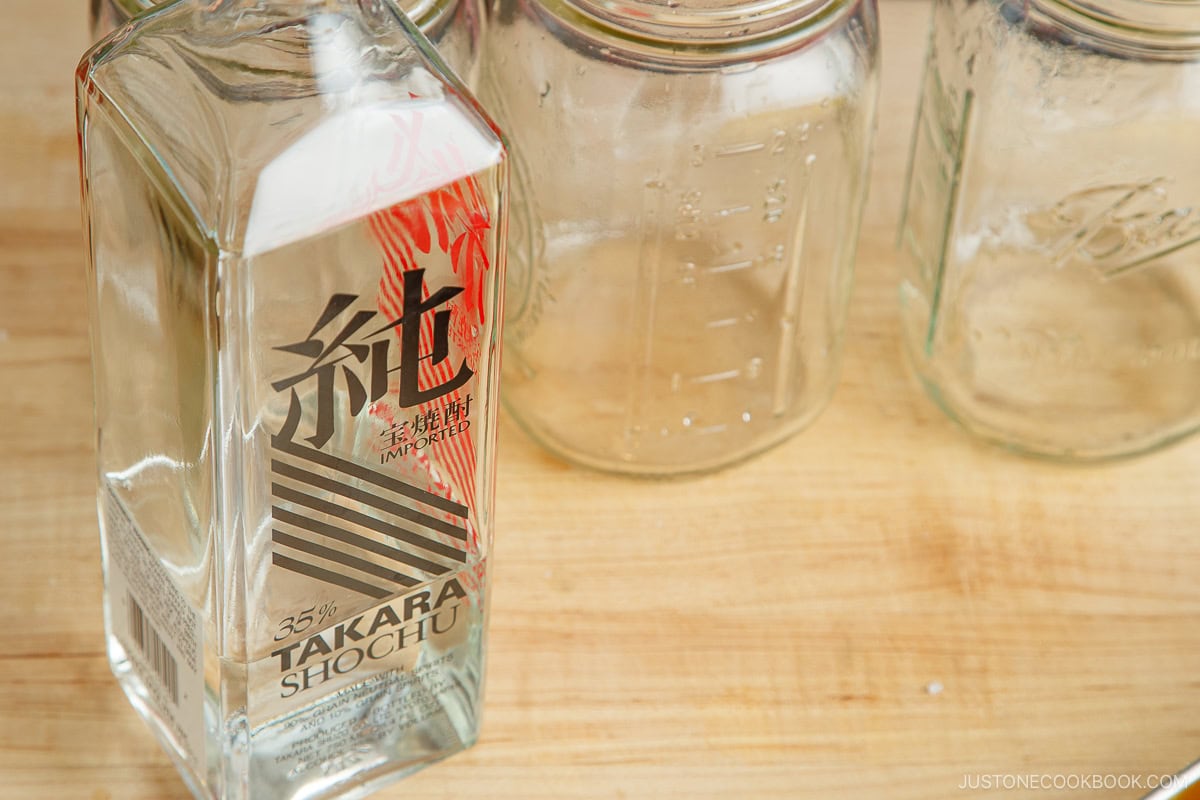
To Prepare the Yuzu Cha
First, fill the bottom of the sterilized jars with a layer of some of the 2.2 lbs white rock sugar. Then, cover the rock sugar with a layer of the yuzu mixture using tongs. Continue alternating the layers until you use all the yuzu.

Along the way, press down on the layers with a spoon to remove any air gaps. End with a layer of rock sugar that completely covers the yuzu.
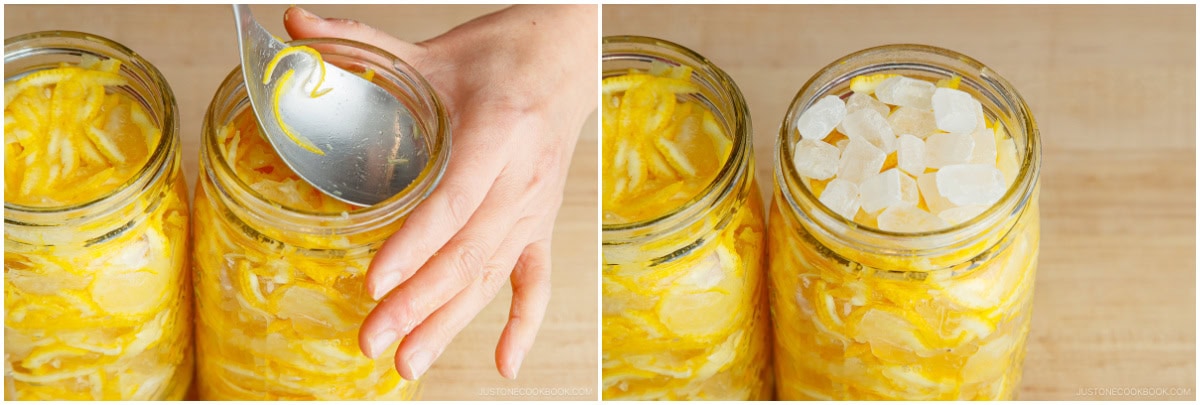
Wipe the jar rims with a clean kitchen towel dampened with shochu.
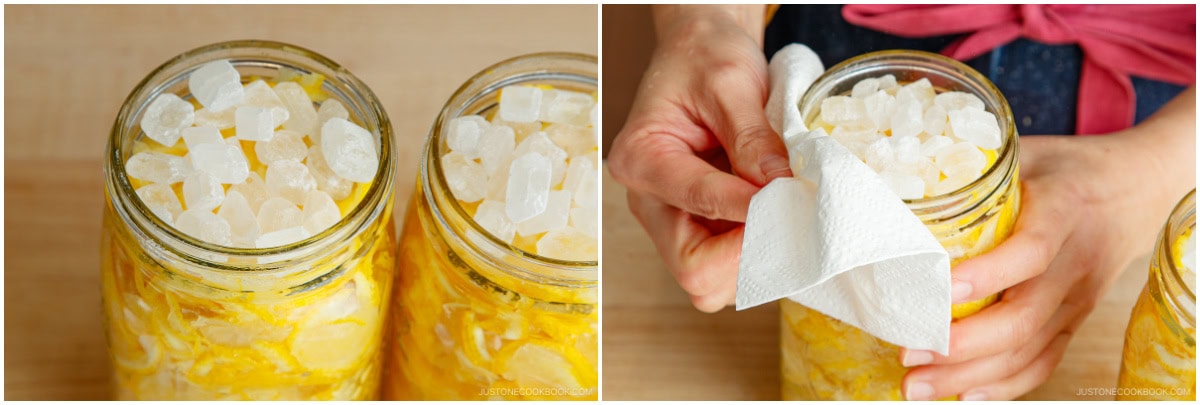
Close the lids.

To Make the Yuzu Cha
Keep the jars in a cool place for about 7 days. If you live in a warm climate, store them in a refrigerator. Gently shake and tilt the jars at least once a day to make sure the yuzu is coated with syrup. The goal is to extract the yuzu flavor quickly. If left exposed and uncoated by rock sugar or syrup, the fruit may grow mold and ruin the syrup.
If you use granulated sugar instead of white rock sugar, store it in the refrigerator immediately after the sugar has completely dissolved.

To Store
At the end of Day 7, move the jars into the fridge, where you can keep them for up to 1–2 months.

To Serve
Add a heaping spoonful of this Yuzu Cha to a cup of hot water and stir well. Enjoy! You can also eat the yuzu rind if you like. I consume everything together.

Author: Namiko Hirasawa Chen
Course: How to
Cuisine: Japanese
Keyword: yuzu
©JustOneCookbook.com Content and photographs are copyright protected. Sharing of this recipe is both encouraged and appreciated. Copying and/or pasting full recipes to any website or social media is strictly prohibited. Please view my photo use policy here.
If you made this recipe, snap a pic and hashtag it #justonecookbook! We love to see your creations on Instagram @justonecookbook!





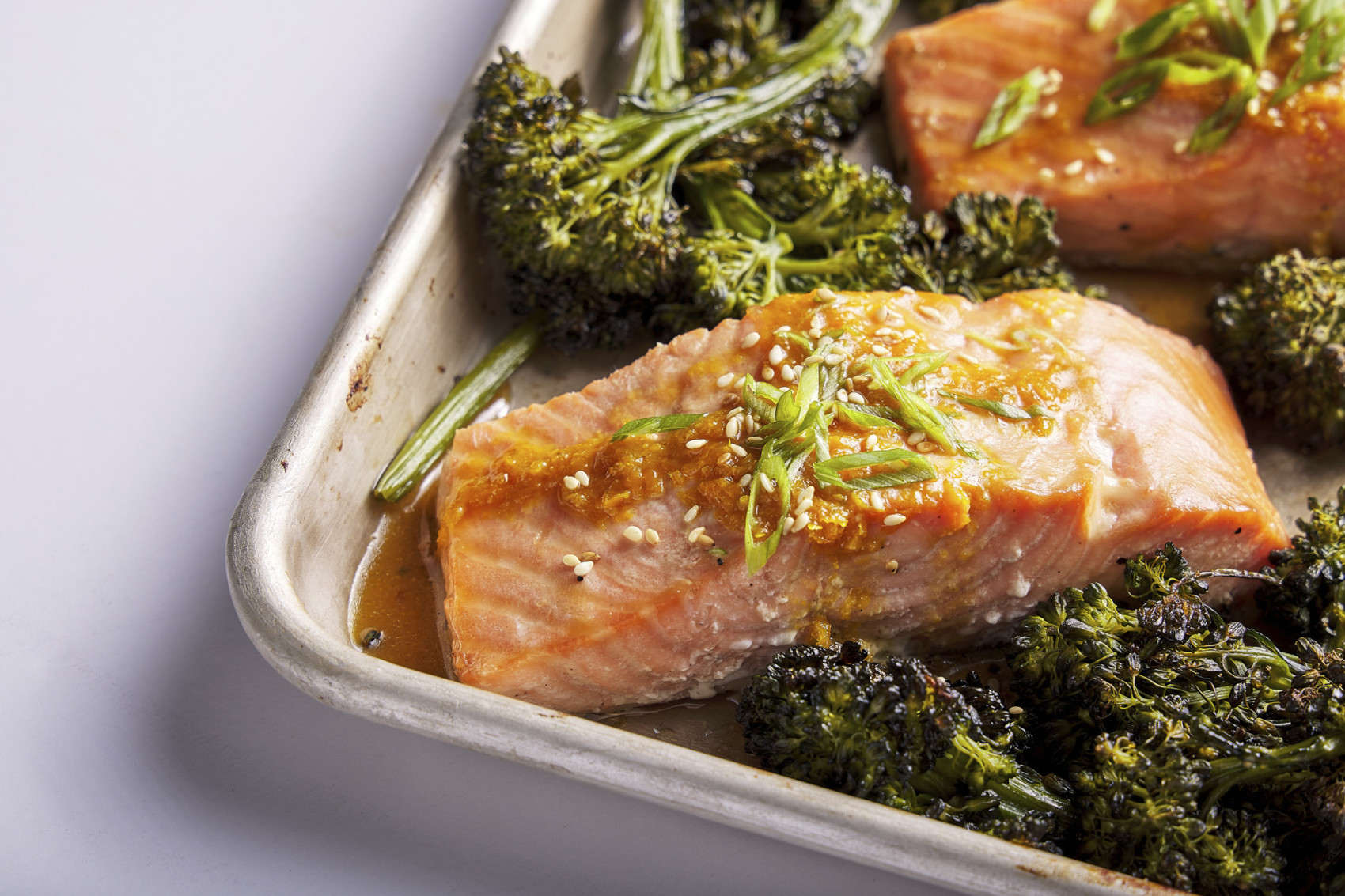





 English (US) ·
English (US) ·